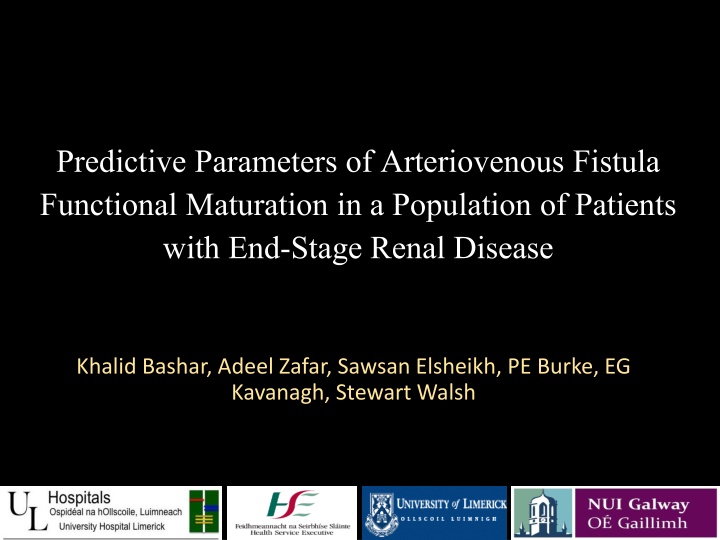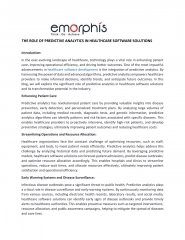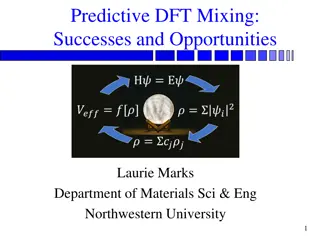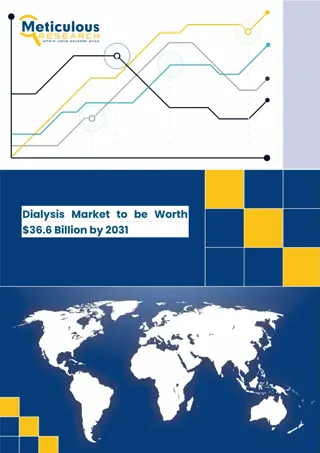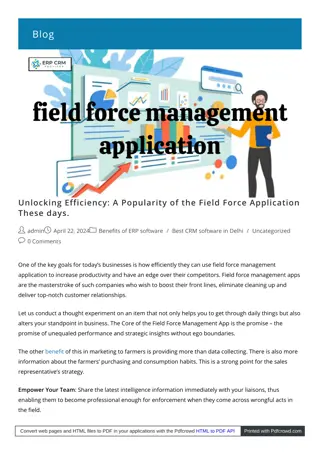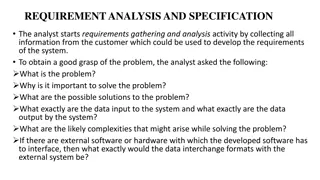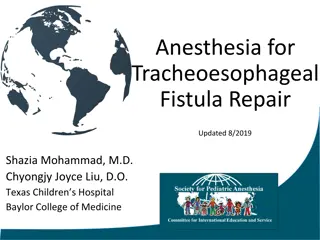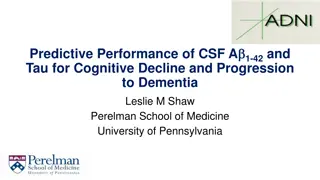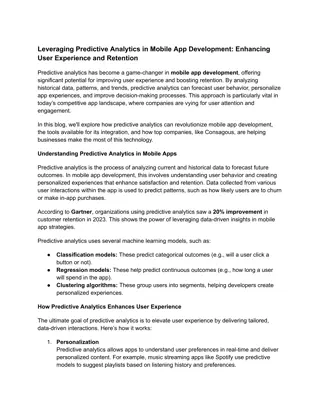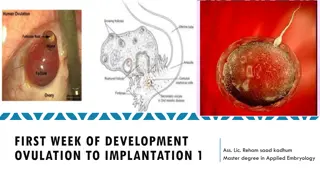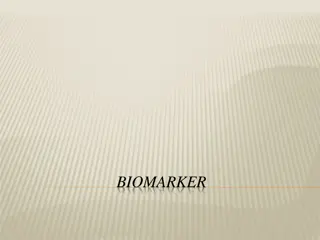Predictive Parameters of Arteriovenous Fistula Functional Maturation in End-Stage Renal Disease Patients
This study explores predictive parameters influencing arteriovenous fistula (AVF) maturation in patients with end-stage renal disease. Various factors impacting AVF functionality and maturation are discussed, providing valuable insights for clinicians managing vascular access in hemodialysis patients.
Uploaded on Feb 24, 2025 | 2 Views
Download Presentation

Please find below an Image/Link to download the presentation.
The content on the website is provided AS IS for your information and personal use only. It may not be sold, licensed, or shared on other websites without obtaining consent from the author.If you encounter any issues during the download, it is possible that the publisher has removed the file from their server.
You are allowed to download the files provided on this website for personal or commercial use, subject to the condition that they are used lawfully. All files are the property of their respective owners.
The content on the website is provided AS IS for your information and personal use only. It may not be sold, licensed, or shared on other websites without obtaining consent from the author.
E N D
Presentation Transcript
Predictive Parameters of Arteriovenous Fistula Functional Maturation in a Population of Patients with End-Stage Renal Disease Khalid Bashar, Adeel Zafar, Sawsan Elsheikh, PE Burke, EG Kavanagh, Stewart Walsh
Introduction Introduction Increased number of patients with ESRD Vascular access required for HD Well functioning AVF is the best modality of access AVF maturation is a complex process of remodelling
Introduction Introduction AVF maturation: Intimal hyperplasia Arterial remodelling Venous remodelling
Introduction Introduction Haemodynamics of fistula maturation Mean arterial blood flow needs to be increased several fold Increased cardiac output Arterial dilatation in response to wall shear stress Medial thickening in response to increased tensile stress Effects mediated by Nitric Oxide (NO), Matrix Metalloproteinases (MMPs), Endothelin and Haemoxygenase 1 (HO-1)
Introduction Introduction Defining a mature AVF: Low resistance conduit Ease of cannulation Rule of 6 Lack of a universal definition
Introduction Introduction AVF advantages (Compared to grafts and Catheters): Last longer Reduced rates of infection and sepsis Fewer secondary interventions The least modality associated with hospitalisation and death Main disadvantage is higher rate of primary failure
Introduction Introduction Timing of initial cannulation: Previous access Patients already on HD Baldrati et al showed that AVF created prior to starting HD had 94.6% patency rate immediately and 72.2% in 2 years, compared to 86.5% immediately and 54.8% in 2 years in patients with AVF created after starting HD Time to mature : 2- 4 weeks
Introduction Introduction The order of preference for creating an AVF: 1. Distal Radio-Cephalic 2. Proximal Radio-Cephalic 3. Brachio-Cephalic 4. Brachio-Basilic (transposed Basilic vein)
Introduction Introduction Basilic vein transposition: First described by Dagher (1976): the use of basilic vein to create an AVF in the upper arm between the end of basilic vein and the side of the brachial artery to act as access for long term haemodialysis Dagher F, Gelber R, Ramos E, Sadler J (1976) The use of basilic vein and brachial artery as an A-V fistula for long term hemodialysis. J Surg Res 20: 373-376
Introduction Introduction One-stage vs Two-stage techniques: One stage: One procedure Faster cannulation for HD More cost-effective Longer incision Technically more demanding and longer
Introduction Introduction One-stage vs Two-stage techniques: Anaya-Ayala et al studied the anatomy of basilic vein: Only 66% of patients are expected to have a normal basilic vein entering one of two paired brachial veins close to the axilla, while up to 34% will have an abnormal variant that would negatively influence the maturation of the newly created fistula Anaya-Ayala JE, Younes HK, Kaiser CL, Syed O, Ismail N, et al. (2011) Prevalence of variant brachial-basilic vein anatomy and implications for vascular access planning. J Vasc Surg 53: 720-724.
Introduction Introduction One-stage vs Two-stage techniques: Two stage: Vein more resistant to torque Easier to mobilise Aim is to reduce complications and improve patency rates Requires two procedures with added costs and increased burden on theatre waiting lists and staff
Aims Aims Audit our own practice in terms of AVF maturation Test the association between certain characteristics (age, gender and medical co-morbidities - diabetes in particular) and AVF maturation Test the association between specific inflammatory markers (Neutrophils and Lymphocytes) obtained preoperatively and AVF maturation.
Methods Methods A retrospective chart review: All patients with ESRD referred for a vascular access Three surgeons performed the procedures. The data-analysis was performed according to a predefined set of outcomes based on extensive search of the literature.
Methods Methods Inclusion Criteria: All patients aged 18 years or older who underwent formation of AVF in the upper limb between 2006 and 2013 In patients with multiple episodes of newly constructed AVFs, each episode was considered separately Exclusion Criteria: Patients that underwent salvage procedures to improve maturation Patients who had prosthetic graft and/or tunnelled catheters as the only means for HD
Methods Methods Primary Endpoints: The association between AVF maturation and: Age, gender, diabetes, smoking, hypertension, hyperlipidaemia, history of steroids use, history of Calcium channel blockers at the time of the access formation and the history of previous dialysis access
Methods Methods Secondary Endpoints: The association between AVF maturation and perioperative blood investigations: Haemoglobin, White cells count, Neutrophils count and Lymphocytes Calculated the NLR as a potential predictor tool for AVF maturation
Definitions Definitions Functional Maturation: Successful use of the arteriovenous fistula for 6 consecutive sessions of HD Primary Patency Rate: Time from access creation to the first surgical intervention required to restore adequate fistula flow
Data Collection Data Collection Ethical approval obtained Data extracted from medical records Blood investigations results: Electronic systems Functional maturation from HD records
Statistical analysis Statistical analysis IBM SPSS version 22.0 Normality tests: Histograms, Q-Q plots and Box Plots Categorical data: Pearson Chi-Square (X2) test Continuous data were reported as mean SD / Median: Normal Distribution: Independent sample t-test Skewed data: Mann-Whitney U
Statistical analysis Statistical analysis Logistic Regression An overall logistic regression test Variables with a p value of < 0.1 in bivariate analysis Functional maturation as the dependent (outcome) measure
Results Results 97 AVFs in 86 patients Aetiology of ESRD: Diabetes (38.1%) Congenital renal agenesis (8.2%) Hypertension (7.2%) Ischaemic injury (6.2%).
Results Results Age of all patients was (mean SD) 60.9 16.9: Men aged 63.7 14.8 with a median of 67 (22 86) Women aged 54.5 19.6 with a median of 55 (21 81) The difference was statistically significant (P = 0.012)
Characteristics of Patients Characteristics of Patients
Characteristics of continuous variables Characteristics of continuous variables
Categorical variables and Maturation Categorical variables and Maturation
Categorical variables and Maturation Categorical variables and Maturation
Categorical variables and Maturation Categorical variables and Maturation
Categorical variables and Maturation Categorical variables and Maturation
Continuous variables and maturation Continuous variables and maturation
Results Results Logistic Regression (All Variables): The overall prediction accuracy of the model was 77.8% Independent predictor for AVF outcomes: Female gender (P = 0.04) History of calcium channel blockers (P = 0.034).
Results Results Logistic Regression (Based on the literature): The overall prediction accuracy of the model was 71.7%, The independent predictor for functional nonmaturation was a female gender (P = 0.011).
Results Results Predictive value of the NLR: Statistical test: Mann-Whitney U NLR of mature AVFs ----> 4.850 (1.8 15.7) NLR of failed AVFs ----> 3.554 (1.7 15.0); The difference was significant (P = 0.024).
The utility of the NLR in predicting AVF maturation outcomes Area Under The Curve 0.629
Discussion Discussion Functional maturation was associated with: Previous history of a kidney transplant (P = 0.036) Low Haemoglobin levels (P = 0.01) Patient on a calcium channel blocker (P = 0.001) Functional non-maturation was associated with: Female gender (P = 0.004)
Discussion Discussion Conflicting evidence with regards to: Female gender Diabetes Age
Limitations Limitations Retrospective Study Small number The use of functional maturation to determine outcomes Lack of preoperative US scans Differentiate failure from mis-cannulation Stratify findings by vein diameter
Conclusion Conclusion Age should not be a limiting factor Female gender can independently predict functional non- maturation in multiple regression analysis Calcium channel blockers might improve maturation rates Large multi-centre registry-based studies needed Biomechanical factors that influence intimal hyperplasia should be considered
Thank You Thank You
Predictive Parameters of Arteriovenous Fistula Functional Maturation in a Population of Patients with End-Stage Renal Disease Khalid Bashar, Adeel Zafar, Sawsan Elsheikh, PE Burke, EG Kavanagh, Stewart Walsh
